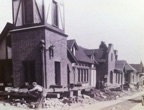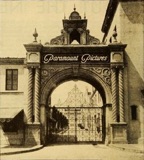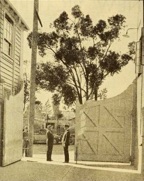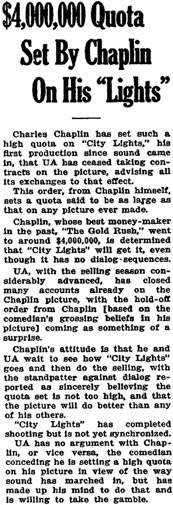City Lights 1930 1931 1932 next previous
City Lights Clippings 134/387
Elena Boland, Los Angeles Times, L. A., Cal., Aug. 31, 1930.
The studio gate of the Paramount Hollywood lot. The minor
studio players and workers are paid at the
little owning-covered window at the left of the gate.
(...) Photo, New Movie, Oct. 1930
& The studio gate to the Warner Brothers‘ lot with the trusty
guardian on the job.
(...) Photo, New Movie, Sept. 1930
& Photo Beam Hollywood (creator), Charlie Chaplin Studio,
Hollywood, postmarked March 8, 1922, postcard
& During the summer, the Chaplin Studio buildings were
moved back 15 feet for the widening of La Brea Avenue – Los
Angeles, 1929, Jim Henson Company
& Bert Wheeler, RKO comedian, passed by a paving crew
at work on La Brea Ave., near the Chaplin studio.
„Well, well,“ he said. „Just another Hollywood artery.“
– Los Angeles Herald.
(...) Motion Picture News, Aug. 16, 1930
& $4,000,000 Quota Set By Chaplin
On His „Lights“
Charles Chaplin has set such a high quota on „City
Lights,“ his first production since sound came in,
that UA has ceased taking contracts on the picture, advising
all its exchanges to that effect. This order, from Chaplin
himself, sets a quota said to be as large as that on any picture
ever made. Chaplin, whose best money-maker
in the past, „The Gold Rush,“ went to around $4,000,000,
is determined that „City Lights“ will get it, even
though it has no dialog-sequences.
(...) Variety, Aug. 27, 1930
„The biggest picture he has ever attempted“
Editorial content. „CHAPLIN STUDIO
UNIQUE IN FILMS
Only One-Man Organization
in Picture Industry
Comedian Works Leisurely
on „The City‘s Streets“
Pantomimist Steadfast to Love
for Silents
BY ELENA BOLAND
It must be called ,the one-man studio‘ so
unpretentious is its management, so dependent on its head
for every activity.
In this day of Hollywood‘s increasing maturity when
motion-picture development must, it seems, be done on the
grand scale, Charlie Chaplin‘s studio stands alone,
unique among organizations of its kind.
The bigger the better is the motto of other plants,
also the more the merrier: They are bound by
organization; tied by system; they run on budgets, conferences
and schedule. They are headed by arrays of executives
who keep watch on production staff, technical staffs, advisory
boards and retinues of assistants. Not to mention stars
and players
PERSONNEL LIMITED
Chaplin‘s studio has none of this. What system it has
accumulated is handled so unnoticeable that the lord
and master can remain unconscious of it. The entire personnel
numbers forty-five. In comparison, a partial list from one
of our prominent lots states that in its employ are twenty-one
executives, twenty-nine directors, thirty-eight writers,
twelve stars and forty featured players. Another of equally
good standing declares ten executives, sixty-eight
writers, twenty-two directors, eleven stars, forty-nine featured
players and a music department of twenty.
Chaplin can‘t. It is impossible for him to work in an
organized atmosphere. In fact, he works backward.
Already he has spent two years, working when in the mood,
making the biggest picture he has ever attempted,
City Lights. It will be finished in five weeks, if he keeps
his promise. But even yet, the story is not written.
Nor will it be until after the film is finally completed.“ (...)
Redaktioneller Inhalt
City Lights 1930 1931 1932 next previous







